
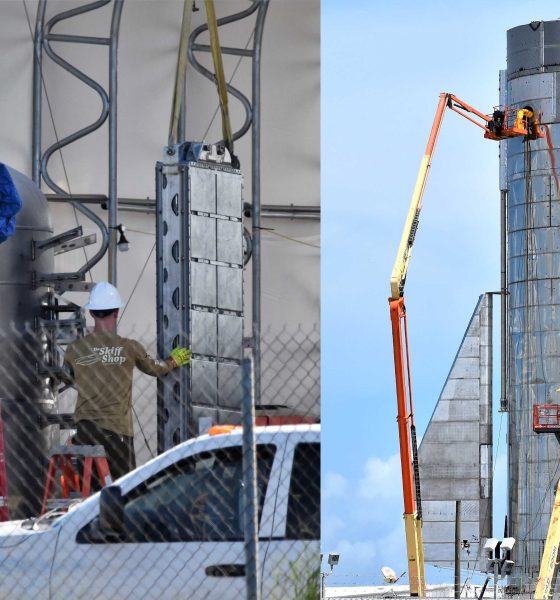
News
SpaceX is installing Tesla battery packs on its Starship MK1 rocket prototype
First noticed by NASASpaceflight.com forum member “exilon”, SpaceX appears to have selected off-the-shelf Tesla battery packs as the power storage method of choice for its Starship Mk1 prototype, currently in the midst of a busy period of integration
Potentially taken directly from Tesla Model S/X powertrains otherwise headed for recycling, SpaceX technicians have spent the last 24 or so hours attaching numerous battery packs to part of a Starship subsystem known as header tanks. This is the latest addition to SpaceX and Tesla’s relatively close relationship – the two have begun to work together to solve challenges with materials science, batteries, and more within the last 12-24 months.
While initially surprising, the appearance of battery packs quite literally taken from Tesla Model S/X vehicles or their Gigafactory assembly line actually makes a lot of sense. By using prepackaged, off-the-shelf battery systems with industry-leading power management capabilities, SpaceX is probably saving a huge amount of time, money, and effort. If the battery packs were already nearing the end of their useful automotive lives, the net cost could very well approach zero, aside from what looks like a minimal mounting brace. It’s possible that SpaceX has even pursued modifying and certifying large Tesla-derived battery packs for use on orbital Starship missions.
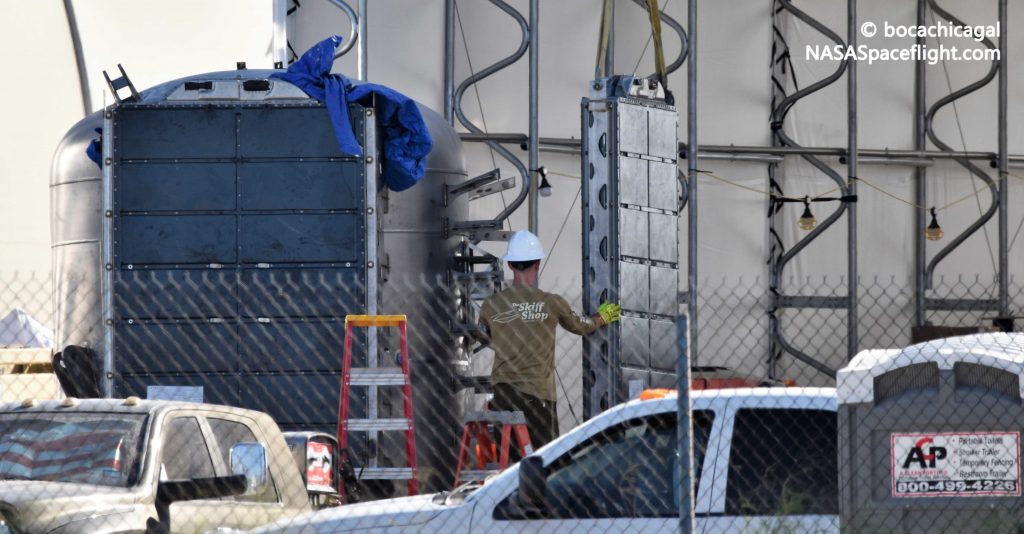
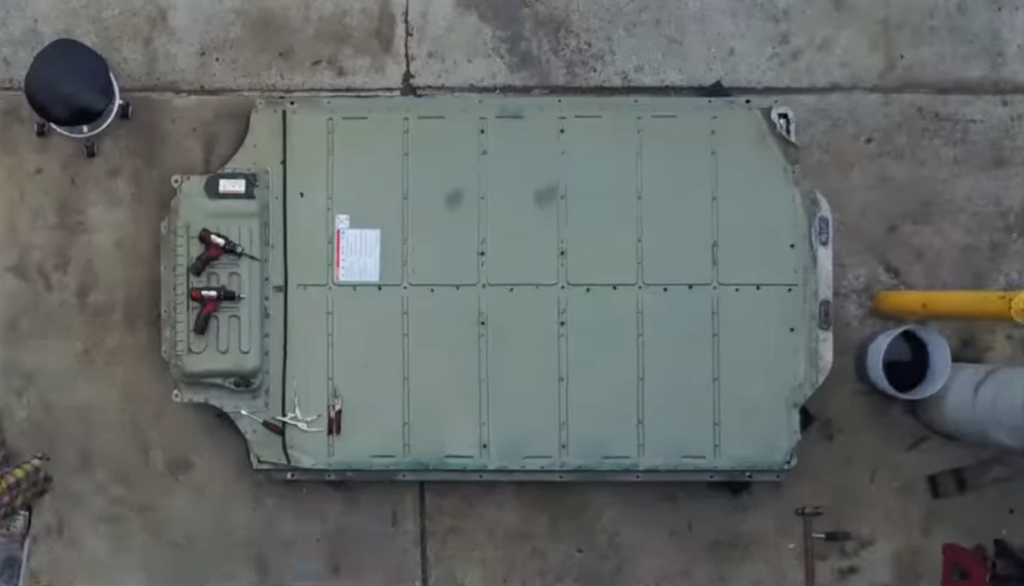
These battery packs were spotted by an eagle-eyed forum user who was first to recognize the hardware for what it likely was. Per the above photo, SpaceX appears to have joined two self-contained Tesla battery packs into single units that were then installed on a header tank. Knowing that the highest capacity Tesla offers is ~100 kWh, the 2×2 packs could store up to 400 kWh and offer instantaneous power output (ignoring thermal limitations) well into the megawatt (MW) range. It’s unclear if the first header tank also had batteries attached but SpaceX technicians began installing that tank inside Starship’s nose cone on the evening September 22nd. Tank #2 will likely follow in the next 24 hours per Musk’s indication that Starship Mk1 would be stacked to its full height on Wednesday.

For unknown reasons, SpaceX is choosing to mount the ~1000 kg (2200 lb) battery pack pairs directly onto the outside of one of Starship Mk1’s two header tanks. These tanks compliment the rocket prototype’s main propellant tanks and are meant to serve as small reserves of fuel (methane) and oxidizer (oxygen) that can be pressurized independently. During dramatic in-space and in-atmosphere maneuvers, the g-forces exerted on Starship could easily find the vehicle’s propellant pushed away from the ‘bottom’ of its main tanks, creating bubbles or voids that can damage and destroy rocket engines if ingested.
Pressurizing the entirety of the main tanks (a cylinder measuring 9m by ~40m or 30×130 ft) is extremely impractical – hence the need for much smaller header tanks. Falcon 9 boosters are able to sidestep this issue because they are small and light enough (relatively speaking) that cold gas thrusters can efficiently generate the positive Gs needed to safely ignite its engines for recovery and landing maneuvers. Empty, Starship alone will likely weigh no less than 4-6 times as much as a Falcon 9 booster (~25 tons, 55,000 lb).

According to CEO Elon Musk, SpaceX has decided to install those header tanks in the very tip of Starship Mk1’s conical nose to help balance out the vehicle’s center of mass. As a side-effect, SpaceX will have to install feed lines that run the entire length of the spacecraft and protect them with steel aero-covers. It’s unclear if this design choice is necessitated by Starship’s early, prototypical form or if – once outfitted with crew quarters or a functional cargo bay – it’s possible that that added mass will serve as enough of a counterbalance to preclude the need for ballast in the nose.
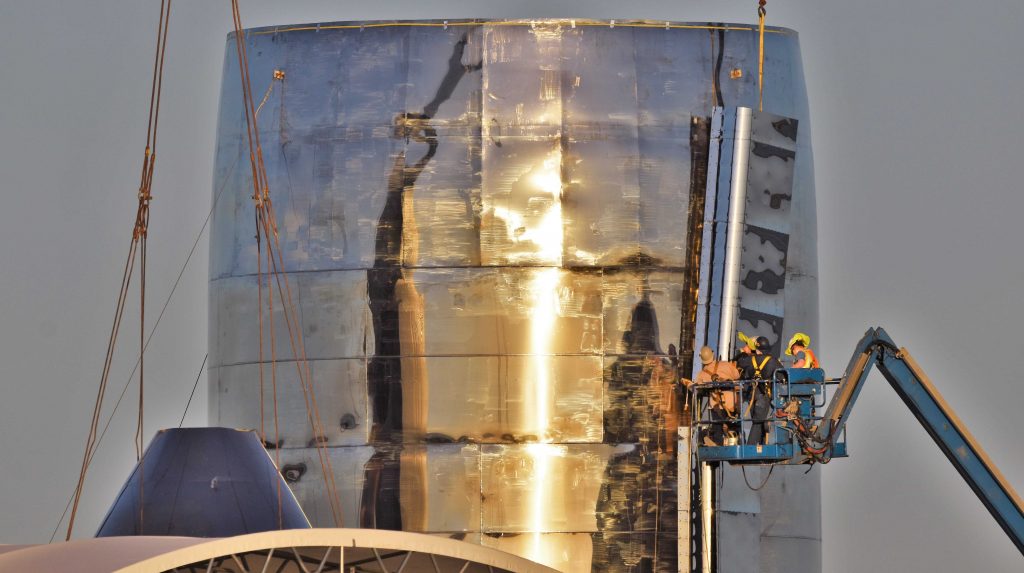
Musk posted a view inside an adjacent SpaceX fabrication facility in Boca Chica on September 23rd, showing a large row of staged steel sheets that will eventually be formed into aerodynamic shrouds for Starship Mk1’s raceways, fins, and wings.
Check out Teslarati’s Marketplace! We offer Tesla accessories, including for the Tesla Cybertruck and Tesla Model 3.

News
Waymo scrutinized after self-driving taxis cause traffic jams during SF blackout
It’s not farfetched to speculate that it would have been a doomsday scenario for Tesla had FSD behaved this way.
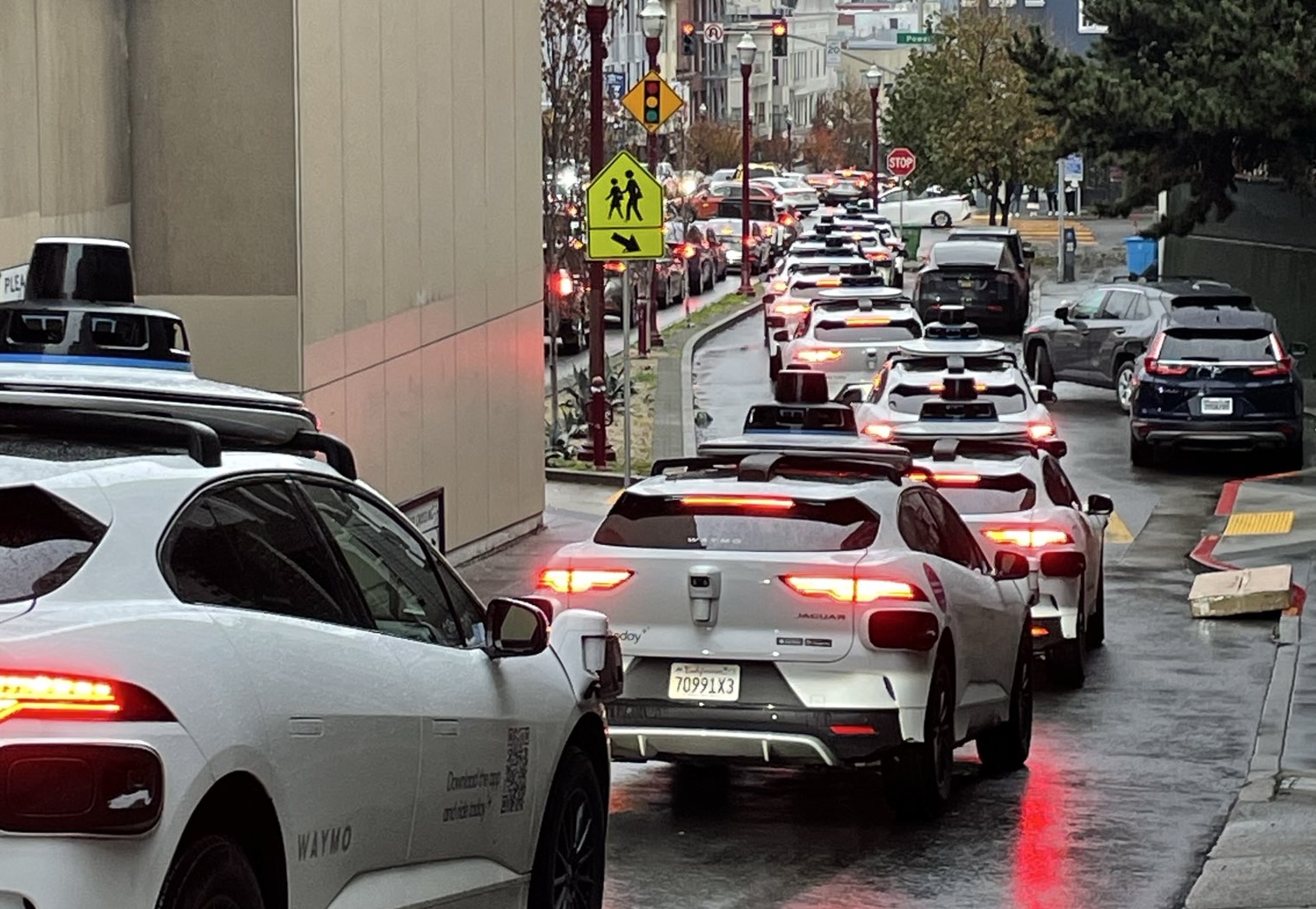
A power outage across San Francisco over the weekend forced numerous Waymo self-driving taxis to stop at darkened intersections and cause traffic blockages in multiple locations across the city. The disruption left riders stranded, frustrated drivers blocked, and city officials stepping in as the Alphabet-owned company temporarily suspended service amid the widespread gridlock.
Needless to say, it would likely have been a doomsday scenario for Tesla had FSD behaved in a similar way, especially if fleets of its robotaxis blocked traffic for numerous drivers.
Power outage halts Waymo fleet
The outage knocked out electricity for tens of thousands of customers, leaving traffic signals dark across large parts of the city, as noted in a report from the New York Times. Waymo vehicles began stopping at intersections and remained stationary for extended periods, seemingly unable to operate. Tow truck operators worked through the night removing immobilized vehicles, while videos circulated online showing Waymos with hazard lights flashing as traffic backed up around them.
Waymo later confirmed that it had paused its Bay Area ride-hailing service after the San Francisco mayor’s office contacted the company about the congestion its vehicles were contributing to. Service began coming back online shortly after 3:30 p.m. local time, though some users still reported being unable to request rides. Waymo maintained that no injuries or accidents were reported during the outage.
Autonomous cars during emergencies
The incident surprised industry observers since autonomous vehicles are designed to function during signal outages and temporary connectivity losses. Waymo stated that its vehicles treat nonfunctional signals as four-way stops, but “the sheer scale of the outage led to instances where vehicles remained stationary longer than usual to confirm the state of the affected intersections. This contributed to traffic friction during the height of the congestion.” Experts suggested the problem may have been linked to the vehicles’ reliance on remote assistance teams, which help resolve complex situations the cars cannot handle independently.
“Yesterday’s power outage was a widespread event that caused gridlock across San Francisco, with non-functioning traffic signals and transit disruptions. While the failure of the utility infrastructure was significant, we are committed to ensuring our technology adjusts to traffic flow during such events,” the Waymo spokesperson stated, adding that it is “focused on rapidly integrating the lessons learned from this event, and are committed to earning and maintaining the trust of the communities we serve every day.”
News
Tesla aims to combat common Full Self-Driving problem with new patent
Tesla writes in the patent that its autonomous and semi-autonomous vehicles are heavily reliant on camera systems to navigate and interact with their environment.

Tesla is aiming to combat a common Full Self-Driving problem with a new patent.
One issue with Tesla’s vision-based approach is that sunlight glare can become a troublesome element of everyday travel. Full Self-Driving is certainly an amazing technology, but there are still things Tesla is aiming to figure out with its development.
Unfortunately, it is extremely difficult to get around this issue, and even humans need ways to combat it when they’re driving, as we commonly use sunglasses or sun visors to give us better visibility.
Cameras obviously do not have these ways to fight sunglare, but a new patent Tesla recently had published aims to fight this through a “glare shield.”
Tesla writes in the patent that its autonomous and semi-autonomous vehicles are heavily reliant on camera systems to navigate and interact with their environment.

The ability to see surroundings is crucial for accurate performance, and glare is one element of interference that has yet to be confronted.
Tesla described the patent, which will utilize “a textured surface composed of an array of micro-cones, or cone-shaped formations, which serve to scatter incident light in various directions, thereby reducing glare and improving camera vision.”

The patent was first spotted by Not a Tesla App.
The design of the micro-cones is the first element of the puzzle to fight the excess glare. The patent says they are “optimized in size, angle, and orientation to minimize Total Hemispherical Reflectance (THR) and reflection penalty, enhancing the camera’s ability to accurately interpret visual data.”
Additionally, there is an electromechanical system for dynamic orientation adjustment, which will allow the micro-cones to move based on the angle of external light sources.
This is not the only thing Tesla is mulling to resolve issues with sunlight glare, as it has also worked on two other ways to combat the problem. One thing the company has discussed is a direct photon count.
CEO Elon Musk said during the Q2 Earnings Call:
“We use an approach which is direct photon count. When you see a processed image, so the image that goes from the sort of photon counter — the silicon photon counter — that then goes through a digital signal processor or image signal processor, that’s normally what happens. And then the image that you see looks all washed out, because if you point the camera at the sun, the post-processing of the photon counting washes things out.”
Future Hardware iterations, like Hardware 5 and Hardware 6, could also integrate better solutions for the sunglare issue, such as neutral density filters or heated lenses, aiming to solve glare more effectively.
Elon Musk
Delaware Supreme Court reinstates Elon Musk’s 2018 Tesla CEO pay package
The unanimous decision criticized the prior total rescission as “improper and inequitable,” arguing that it left Musk uncompensated for six years of transformative leadership at Tesla.

The Delaware Supreme Court has overturned a lower court ruling, reinstating Elon Musk’s 2018 compensation package originally valued at $56 billion but now worth approximately $139 billion due to Tesla’s soaring stock price.
The unanimous decision criticized the prior total rescission as “improper and inequitable,” arguing that it left Musk uncompensated for six years of transformative leadership at Tesla. Musk quickly celebrated the outcome on X, stating that he felt “vindicated.” He also shared his gratitude to TSLA shareholders.
Delaware Supreme Court makes a decision
In a 49-page ruling Friday, the Delaware Supreme Court reversed Chancellor Kathaleen McCormick’s 2024 decision that voided the 2018 package over alleged board conflicts and inadequate shareholder disclosures. The high court acknowledged varying views on liability but agreed rescission was excessive, stating it “leaves Musk uncompensated for his time and efforts over a period of six years.”
The 2018 plan granted Musk options on about 304 million shares upon hitting aggressive milestones, all of which were achieved ahead of time. Shareholders overwhelmingly approved it initially in 2018 and ratified it once again in 2024 after the Delaware lower court struck it down. The case against Musk’s 2018 pay package was filed by plaintiff Richard Tornetta, who held just nine shares when the compensation plan was approved.
A hard-fought victory
As noted in a Reuters report, Tesla’s win avoids a potential $26 billion earnings hit from replacing the award at current prices. Tesla, now Texas-incorporated, had hedged with interim plans, including a November 2025 shareholder-approved package potentially worth $878 billion tied to Robotaxi and Optimus goals and other extremely aggressive operational milestones.
The saga surrounding Elon Musk’s 2018 pay package ultimately damaged Delaware’s corporate appeal, prompting a number of high-profile firms, such as Dropbox, Roblox, Trade Desk, and Coinbase, to follow Tesla’s exodus out of the state. What added more fuel to the issue was the fact that Tornetta’s legal team, following the lower court’s 2024 decision, demanded a fee request of more than $5.1 billion worth of TSLA stock, which was equal to an hourly rate of over $200,000.
Delaware Supreme Court Elon Musk 2018 Pay Package by Simon Alvarez








